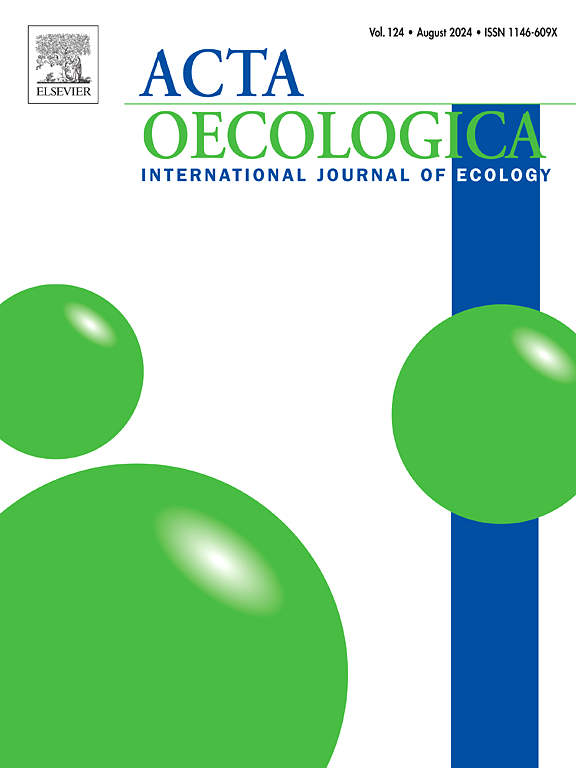Seasonal variation in arbuscular mycorrhizal colonization in three Asteraceae species in a temperate secondary forest
IF 1.3
4区 环境科学与生态学
Q3 ECOLOGY
Acta Oecologica-International Journal of Ecology
Pub Date : 2025-09-27
DOI:10.1016/j.actao.2025.104128
引用次数: 0
Abstract
Arbuscular mycorrhizal fungi (AMF) colonize plant roots, facilitating water absorption and the acquisition of nutrients essential for plant growth and reproduction. This association is present in all terrestrial ecosystems and is also common in secondary vegetation species. Despite their importance in various ecological processes in temperate forests, AMF patterns in the Asteraceae family, have been scarcely studied. There are few studies that explicitly link plant biological traits and seasonal edaphic variability to colonization dynamics. The objective of this research was to evaluate the existence of patterns in the arbuscular mycorrhizal association of three Asteraceae family species of secondary vegetation, Ageratina glabrata, Roldana angulifolia and Roldana barba-johannis, explained by some biological traits of the plant species and some edaphic factors of the site. Significant differences in AMF colonization were detected. Hyphae and spore colonization increased during the rainy season, while arbuscule frequency increased during the dry season. Generalized linear model results showed that species identity and its interaction with the site significantly affected plant height and coverage. R. barba-johannis exhibited a significant and positive correlation between coverage and arbuscule colonization. Canonical correspondence analysis revealed that fungal colonization was primarily associated with higher soil moisture, organic matter, and nutrient availability during the rainy season. Conversely, arbuscule colonization and plant growth during the dry season were related to light availability and ammonium levels. It was shown that AMF colonization of Asteraceae shrubs is strongly influenced by a combination of biological, edaphic and seasonal factors.
温带次生林中三种菊科植物丛枝菌根定植的季节变化
丛枝菌根真菌(AMF)定植于植物根系,促进植物生长和繁殖所必需的水分吸收和营养物质的获取。这种关联存在于所有陆地生态系统中,在次生植被物种中也很常见。尽管它们在温带森林的各种生态过程中具有重要意义,但对菊科AMF模式的研究却很少。很少有研究明确地将植物生物学性状和季节土壤变异与定殖动态联系起来。本研究的目的是评价菊科次生植被Ageratina glabrata、Roldana angulifolia和Roldana barba-johannis 3种植物的丛枝菌根结扎模式的存在,并从该植物的一些生物学特性和立地的一些土壤因素进行解释。检测到AMF定殖的显著差异。菌丝和孢子定殖在雨季增加,而丛枝频率在旱季增加。广义线性模型结果表明,物种身份及其与立地的相互作用对植物高度和盖度有显著影响。barba-johannis的盖度与丛枝定殖呈显著正相关。典型对应分析表明,真菌的定植主要与雨季较高的土壤湿度、有机质和养分有效性有关。反之,旱季丛枝定植和植株生长与光效和铵含量有关。结果表明,AMF在菊科灌木中的定殖受生物、土壤和季节因素的综合影响。
本文章由计算机程序翻译,如有差异,请以英文原文为准。
求助全文
约1分钟内获得全文
求助全文
来源期刊
CiteScore
3.60
自引率
0.00%
发文量
57
审稿时长
>0 weeks
期刊介绍:
Acta Oecologica is venue for the publication of original research articles in ecology. We encourage studies in all areas of ecology, including ecosystem ecology, community ecology, population ecology, conservation ecology and evolutionary ecology. There is no bias with respect to taxon, biome or geographic area. Both theoretical and empirical papers are welcome, but combinations are particularly sought. Priority is given to papers based on explicitly stated hypotheses. Acta Oecologica also accepts review papers.

 求助内容:
求助内容: 应助结果提醒方式:
应助结果提醒方式:


